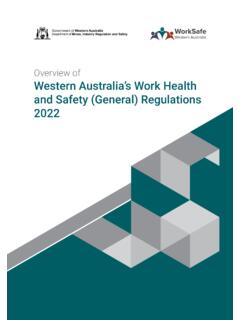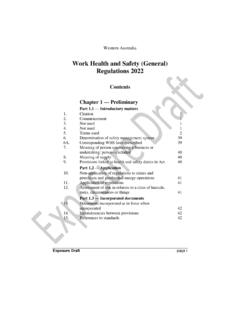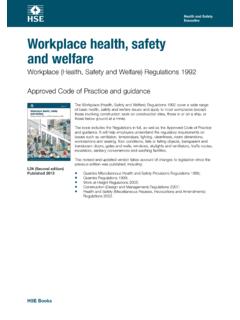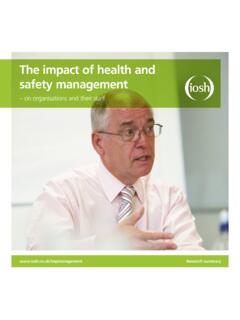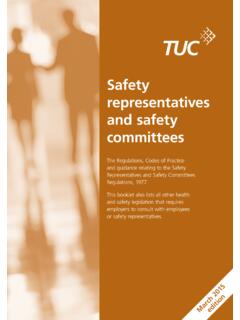Transcription of Health and safety regulation a short guide HSC13
1 Health and safety Executive Health and safety .. a short guide Why this guide ? Health and safety regulation .. a short guide The Health and safety Commission (HSC) conducted a review of Health and safety regulation in 1994. It found that people were confused about the differences between: guidance; Approved Codes of Practice (ACOPs); and regulations and how they relate to each other. This document aims to explain how each fits in. It is for employers and self . employed people, but will be of interest to anyone who wants to know how Health This is a web friendly and safety law is meant to work.
2 Version of leaflet HSC13 (rev1), revised 08/03 What Health and safety law requires The basis of British Health and safety law is the Health and safety at Work etc Act 1974. The Act sets out the general duties which employers have towards employees and members of the public, and employees have to themselves and to each other. These duties are qualified in the Act by the principle of so far as is reasonably practicable'. In other words, an employer does not have to take measures to avoid or reduce the risk if they are technically impossible or if the time, trouble or cost of the measures would be grossly disproportionate to the risk.
3 What the law requires here is what good management and common sense would lead employers to do anyway: that is, to look at what the risks are and take sensible measures to tackle them. The Management of Health and safety at Work regulations 1999 (the Management regulations ) generally make more explicit what employers are required to do to manage Health and safety under the Health and safety at Work Act. Like the Act, they apply to every work activity. The main requirement on employers is to carry out a risk assessment.
4 Employers with five or more employees need to record the significant findings of the risk assessment. Risk assessment should be straightforward in a simple workplace such as a typical office. It should only be complicated if it deals with serious hazards such as those on a nuclear power station, a chemical plant, laboratory or an oil rig. 1 of 7 pages Health and safety Executive The HSE leaflet Five steps to risk assessment will give you more information. Besides carrying out a risk assessment, employers also need to: make arrangements for implementing the Health and safety measures identified as necessary by the risk assessment; appoint competent people (often themselves or company colleagues) to help them to implement the arrangements; set up emergency procedures; provide clear information and training to employees.
5 Work together with other employers sharing the same workplace. Other regulations require action in response to particular hazards, or in industries where hazards are particularly high. A list of the main regulations which apply generally is in Appendix 1. Many are not qualified by reasonable practicability'. European law In recent years much of Britain's Health and safety law has originated in Europe. Proposals from the European Commission may be agreed by Member States, who are then responsible for making them part of their domestic law.
6 Modern Health and safety law in this country, including much of that from Europe, is based on the principle of risk assessment described above. Action on Health and safety : Options The Health and safety Commission and its operating arm, the Executive (HSC/E), have spent over twenty years modernising the structure of Health and safety law. Their aims are to protect the Health , safety and welfare of employees, and to safeguard others, principally the public, who may be exposed to risks from work activity. HSC/E consult fully with people affected by their legislative proposals, and adopt various approaches based on assessing and controlling risk (see What Health and safety law requires').
7 Among the things that can prompt action from HSC/E are: changes in technologies, industries or risks; evidence of accidents and ill Health , plus public concern; European Directives. Where HSC/E consider action is necessary to supplement existing arrangements, their three main options are: guidance; Approved Codes of Practice; and regulations . HSC/E try to take whichever option, or options, allows employers most flexibility and costs them least, while providing proper safeguards for employees and the public. Health and safety regulation 2 of 7 pages Health and safety Executive Guidance HSE publishes guidance on a range of subjects (please see the end of this guide ).
8 Guidance can be specific to the Health and safety problems of an industry or of a particular process used in a number of industries. The main purposes of guidance are: to interpret helping people to understand what the law says including for example how requirements based on EC Directives fit with those under the Health and safety at Work Act; to help people comply with the law;. to give technical advice. Following guidance is not compulsory and employers are free to take other action. But if they do follow guidance they will normally be doing enough to comply with the law.
9 (Please also see the sections below on Approved Codes of Practice and regulations , which explain other ways in which employers are helped to know whether they are doing what the law requires.) HSC/E aim to keep guidance up to date, because as technologies change, risks and the measures needed to address them change too. Approved Codes of Practice Approved Codes of Practice offer practical examples of good practice. They give advice on how to comply with the law by, for example, providing a guide to what is reasonably practicable'.
10 For example, if regulations use words like suitable and sufficient', an Approved Code of Practice can illustrate what this requires in particular circumstances. Approved Codes of Practice have a special legal status. If employers are prosecuted for a breach of Health and safety law, and it is proved that they have not followed the relevant provisions of the Approved Code of Practice, a court can find them at fault unless they can show that they have complied with the law in some other way. HSC consulted in 1995 on the role of Approved Codes of Practice in the Health and safety system and concluded that they could still be used in support of legal duties in specific circumstances.










